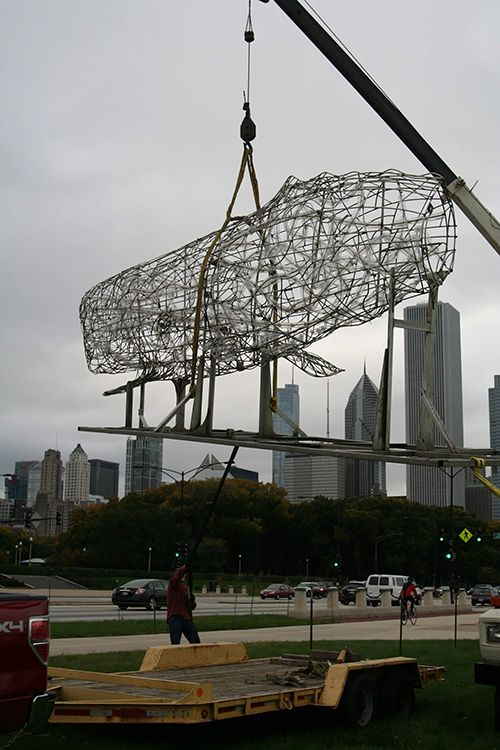
Juarez Hawkins
Among the work featured in her talk is the sculpture “Shirley Armstrong” by Peoria artist Preston Jackson. The piece is a life-sized sperm whale dying because of all the plastic bottles she has ingested from the debris in the oceans of the world. The piece is currently installed at Calumet Park in Chicago but may come to Peoria sometime this year.
In her lecture, Hawkins presents African American artists and their interpretation of corporate influences on communities of color. She provides insight into issues of clean water, clean air and pesticide contamination through the lens of art.
Water rights, global warming, landfills and creative reuse and recycling are all issues that gain new poignancy and relevance through the artists’ perspectives.
Her discussion of Afrofuturism explores African diaspora culture and technology and connects shared experiences.
Through art, she explores “cautionary warnings about excess, waste, creative reuse and a vision for a bigger, brighter future,” she said, noting that in her own work she uses recycled and up-cycled material.
The mythology of America’s development fails to note the exploitation of colonialism and instead promotes “manifest destiny” and the notion of abundant resources free for the taking –– from massive killing of buffalo to claiming land and water rights.
“That is what ‘made America great.’ Native indigenous peoples were in the way. African people were free labor. That (thinking) is rooted in the fiber of our country. Have we reached a tipping point? We have to keep hope,” she said.
“COVID-19 taught us we need to reset, regroup. Will corporations get that message? The power of art is it makes all this more apparent.”
Art gives new insights without words, it stirs feelings and provokes emotions; it can take something felt and translate it into something seen, she said.
Hawkins teaches art history at Chicago State University. Art history typically covers the history of art without adequately presenting the rich and diverse contribution of African American artists.
“The tropes of what African American art should be include images of jazz musicians and women with jugs of water on their heads. It’s important to present work at a different level. It’s easy to fall into the notion that Black artists don’t tackle the environment,” she said, noting that proof of that fallacy abounds.
Register to access Hawkins lecture at the Fine Arts Society of Peoria website at FineArtsSociety.net or by emailing FAS_President@comcast.net.

Preston Jackson’s sculpture “Shirley Armstrong” is lowered into position in Calumet Park in Chicago. The sperm whale is dying from the plastic bottles she has injested from garbage floating in the ocean. (PHOTO BY PRESTON JACKSON)
Artist statement by Preston Jackson about his sculpture “Shirley Armstrong:”
She was always interested in plants, a natural botanist. Her ancestors were from the west coast of Africa, near the Ivory Coast. Just like her numerous plants, she had many children, who came in a rainbow of colors. She was born at the time of the Springfield, Illinois, riots, and the many other race riots in this country. She had a deep-seated love for animals, automatically showing her nurturing ways and maternal instincts. What inspired me to create this large female sperm whale was a person named Shirley Armstrong–because of my connection with this resilient woman who is very much in my everyday life, my DNA, my dreams.
Being the largest of the toothed whale species, I admire the sperm whale’s tenacity in defending her calves and herself. The plastic bottles that she has ingested will soon be the reason for her demise. She unknowingly carries this dangerous material, yet she continues to exist in a brave and proud manner, living each day as if it were a celebration. During my research of this magnificent animal and her behavior I found her reminiscent of Shirley Armstrong. They both have a number of characteristics in common—they are strong and sleek objects of beauty, with strong maternal instincts.
This plastic pollution is well known as a silent killer and will someday draw our attention to what we must do as a human species to rid the earth of the pollutants we carelessly manufacture and inject into our food chain. This sculpture is about the preservation of the planet. From plankton to large mammals, it is important how we treat animals and the earth we live on.
“Speak their names and they live again.”

Recent Comments